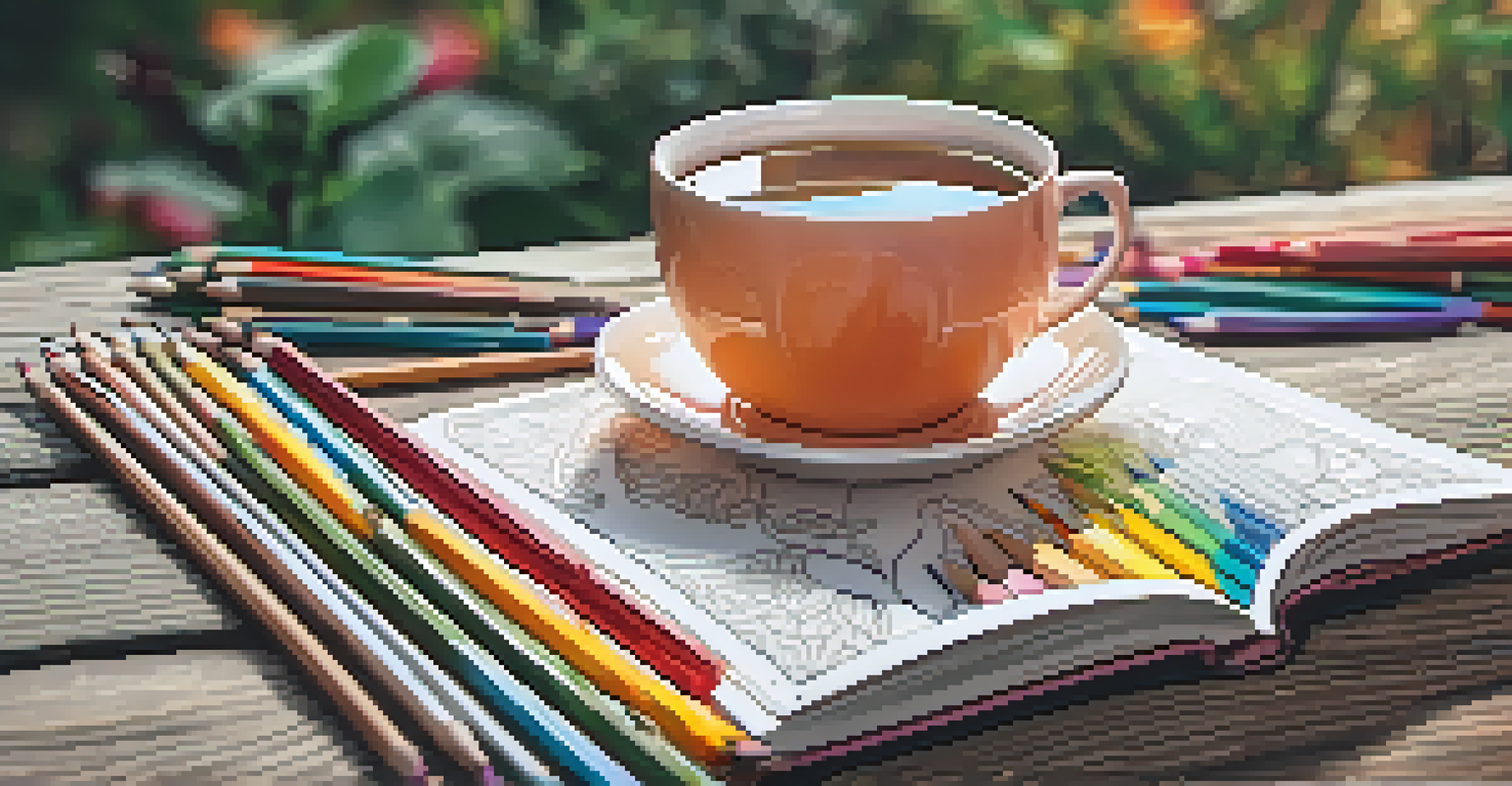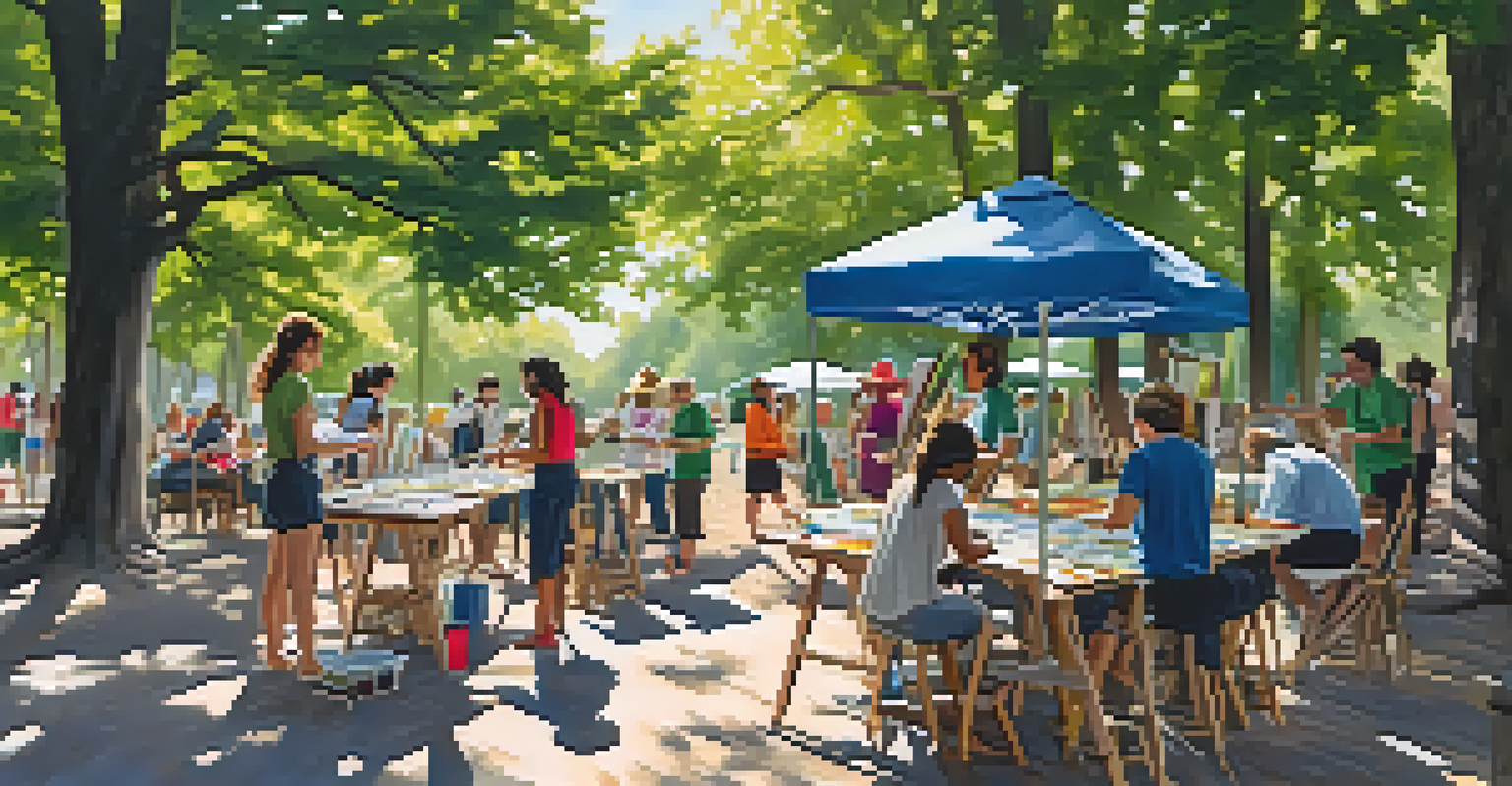Art as a Tool for Stress Relief: Techniques and Benefits

Understanding Art as a Stress Relief Tool
Art has long been recognized as a powerful form of expression, but did you know it can also be a fantastic tool for stress relief? Engaging in artistic activities allows individuals to channel their emotions and thoughts into something tangible, often leading to a sense of release. Whether it's painting, drawing, or crafting, these activities can distract the mind from daily stressors and provide a calming focus.
Every artist dips his brush in his own soul, and paints his own nature into his pictures.
When you immerse yourself in creating art, your brain shifts its attention away from stress and anxiety. This process often leads to what's known as a 'flow state', where you become completely absorbed in the activity. In this state, worries can fade into the background, allowing for a moment of peace amidst the chaos of life.
Moreover, art encourages mindfulness, which is the practice of being present in the moment. By concentrating on your artistic expression, you can cultivate a sense of tranquility, making art not just a hobby, but a therapeutic tool for managing stress.
Different Artistic Techniques for Stress Relief
There are numerous artistic techniques that can serve as effective stress relievers. For instance, coloring books designed for adults have surged in popularity. The repetitive motion of coloring can soothe the mind, akin to meditation, making it a simple yet effective way to unwind after a long day.

Another technique is journaling or creative writing, which allows individuals to process their thoughts and emotions. Putting pen to paper can be incredibly cathartic, helping to clarify feelings and promote emotional healing. It's a personal space where you can express yourself without judgment.
Art as a Stress Relief Tool
Engaging in artistic activities helps channel emotions and promotes a sense of calm.
Finally, consider exploring photography or digital art. Capturing moments or creating visuals can help shift your perspective, allowing you to focus on beauty rather than stress. These activities not only stimulate creativity but also encourage you to notice the world around you, fostering a sense of appreciation.
Benefits of Art for Mental Health
The benefits of engaging in art for mental health are numerous and well-documented. Studies have shown that artistic expression can reduce symptoms of anxiety and depression. When we create, our brains release dopamine, the 'feel-good' neurotransmitter, which can boost mood and promote overall well-being.
Art enables us to find ourselves and lose ourselves at the same time.
Moreover, art can foster a sense of accomplishment. Completing a piece of art, no matter how simple or complex, can provide a tangible sense of achievement. This can be particularly important for individuals struggling with self-esteem issues, as it reinforces the idea that they can create something meaningful.
Additionally, sharing art with others can build social connections. Whether through a local art class or an online community, discussing your work can lead to supportive interactions, further enhancing mental health. The social aspect of art can help combat feelings of isolation, which is often a contributor to stress.
Setting Up Your Creative Space
Creating an inviting space for your artistic endeavors can significantly enhance your experience. Choose a location that feels comfortable and inspiring, whether it’s a corner of your home or a quiet park. Having a dedicated area for art can help signal your brain that it’s time to relax and create.
Consider the elements that make your space enjoyable. Good lighting, comfortable seating, and easy access to materials can make a big difference. Surround yourself with items that inspire you, like photographs, plants, or even your favorite music, to elevate your mood and creativity.
Benefits for Mental Health
Artistic expression can boost mood, enhance self-esteem, and build social connections.
Lastly, remember that your creative space doesn't have to be clutter-free or perfect. Embrace the messiness of the creative process! A space that reflects your personality and artistic journey can be both motivating and comforting, encouraging you to express yourself freely.
Incorporating Art into Your Daily Routine
Finding time for art in your daily routine doesn’t have to be daunting. Start small by setting aside just 10-15 minutes each day for creative activities. This could be doodling, journaling, or even practicing a new art technique. The key is consistency; small, regular sessions can lead to significant stress relief over time.
You might also consider joining a class or workshop. These settings not only provide you with structure but also connect you with like-minded individuals who share your interests. Group sessions can be particularly energizing, as they foster a community spirit and provide motivation to keep creating.
Lastly, don’t be too hard on yourself. The goal is not to produce a masterpiece but to enjoy the process and express yourself. Embrace imperfections and allow your creativity to flow without judgment. This mindset can transform your artistic practice into a delightful escape from daily stress.
Art Therapy: A Professional Approach to Healing
For those struggling with deeper emotional issues, art therapy offers a professional approach to healing. This form of therapy utilizes art as a medium for expression and communication, guided by a trained therapist. Together, they explore the underlying feelings that may be challenging to articulate with words alone.
Art therapists employ various techniques tailored to individual needs, such as painting, drawing, or sculpting. This personalized approach allows clients to explore their emotions at their own pace, fostering a sense of safety and support in the therapeutic process. It’s a powerful way to confront and heal from trauma or stress.
Easy Ways to Incorporate Art Daily
Setting aside just 10-15 minutes a day for creative activities can significantly reduce stress.
Furthermore, art therapy is not just for those with clinical concerns; it can benefit anyone looking to enhance their emotional well-being. Engaging with a professional can provide new insights and coping strategies, making it a valuable resource for stress relief.
Final Thoughts on Art and Stress Relief
In conclusion, art serves as a versatile and effective tool for stress relief. Whether you’re a seasoned artist or a complete beginner, the benefits of engaging in creative activities are accessible to everyone. Art not only provides an outlet for expression but also encourages mindfulness and promotes emotional well-being.
Remember, there’s no right or wrong way to create art. The process itself is what matters most. So, grab some supplies, find a cozy spot, and let your creativity flow. You might be surprised at how much lighter you feel after just a short session of artistic expression.

Ultimately, integrating art into your life can lead to a more balanced and fulfilling existence. So, don’t hesitate—start exploring the world of art as a means to relieve stress and discover the joy it can bring.